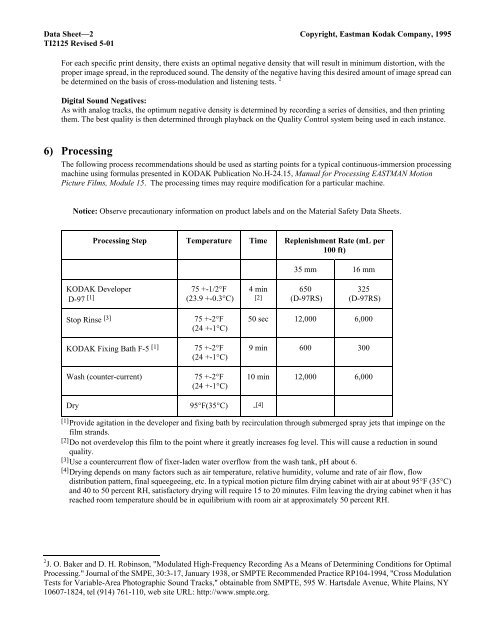EASTMAN EXR Sound Recording Film 2378E, 3378E ... - Kodak
EASTMAN EXR Sound Recording Film 2378E, 3378E ... - Kodak
EASTMAN EXR Sound Recording Film 2378E, 3378E ... - Kodak
Create successful ePaper yourself
Turn your PDF publications into a flip-book with our unique Google optimized e-Paper software.
Data Sheet—2 Copyright, Eastman <strong>Kodak</strong> Company, 1995<br />
TI2125 Revised 5-01<br />
For each specific print density, there exists an optimal negative density that will result in minimum distortion, with the<br />
proper image spread, in the reproduced sound. The density of the negative having this desired amount of image spread can<br />
be determined on the basis of cross-modulation and listening tests. 2<br />
Digital <strong>Sound</strong> Negatives:<br />
As with analog tracks, the optimum negative density is determined by recording a series of densities, and then printing<br />
them. The best quality is then determined through playback on the Quality Control system being used in each instance.<br />
6) Processing<br />
The following process recommendations should be used as starting points for a typical continuous-immersion processing<br />
machine using formulas presented in KODAK Publication No.H-24.15, Manual for Processing <strong>EASTMAN</strong> Motion<br />
Picture <strong>Film</strong>s, Module 15. The processing times may require modification for a particular machine.<br />
Notice: Observe precautionary information on product labels and on the Material Safety Data Sheets.<br />
Processing Step Temperature Time Replenishment Rate (mL per<br />
100 ft)<br />
KODAK Developer<br />
D-97 [1]<br />
75 +-1/2°F<br />
(23.9 +-0.3°C)<br />
Stop Rinse [3] 75 +-2°F<br />
(24 +-1°C)<br />
KODAK Fixing Bath F-5 [1] 75 +-2°F<br />
(24 +-1°C)<br />
Wash (counter-current) 75 +-2°F<br />
(24 +-1°C)<br />
4 min<br />
[2]<br />
Dry 95°F(35°C) - [4]<br />
35 mm 16 mm<br />
650<br />
(D-97RS)<br />
325<br />
(D-97RS)<br />
50 sec 12,000 6,000<br />
9 min 600 300<br />
10 min 12,000 6,000<br />
[1] Provide agitation in the developer and fixing bath by recirculation through submerged spray jets that impinge on the<br />
film strands.<br />
[2] Do not overdevelop this film to the point where it greatly increases fog level. This will cause a reduction in sound<br />
quality.<br />
[3] Use a countercurrent flow of fixer-laden water overflow from the wash tank, pH about 6.<br />
[4] Drying depends on many factors such as air temperature, relative humidity, volume and rate of air flow, flow<br />
distribution pattern, final squeegeeing, etc. In a typical motion picture film drying cabinet with air at about 95°F (35°C)<br />
and 40 to 50 percent RH, satisfactory drying will require 15 to 20 minutes. <strong>Film</strong> leaving the drying cabinet when it has<br />
reached room temperature should be in equilibrium with room air at approximately 50 percent RH.<br />
2 J. O. Baker and D. H. Robinson, "Modulated High-Frequency <strong>Recording</strong> As a Means of Determining Conditions for Optimal<br />
Processing." Journal of the SMPE, 30:3-17, January 1938, or SMPTE Recommended Practice RP104-1994, "Cross Modulation<br />
Tests for Variable-Area Photographic <strong>Sound</strong> Tracks," obtainable from SMPTE, 595 W. Hartsdale Avenue, White Plains, NY<br />
10607-1824, tel (914) 761-110, web site URL: http://www.smpte.org.

















